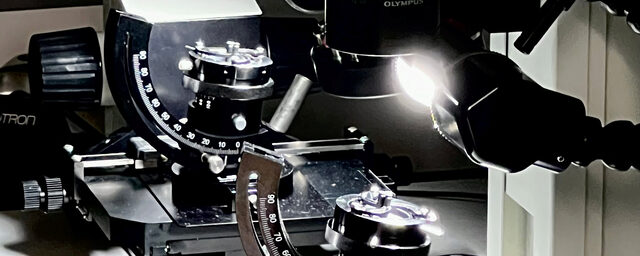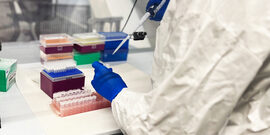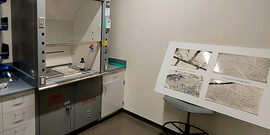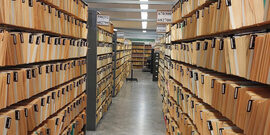The Crime Laboratory Unit performs testing in the following disciplines: Forensic Biology, Firearms and Toolmarks, Trace Evidence, Impressions, Breath Alcohol, and Drug Chemistry. Eight members of the Crime Lab are certified in their respective disciplines.
Forensic Chemistry
The Forensic Chemistry section is composed of the subdisciplines of Forensic Breath Alcohol Analysis and Drug Chemistry Analysis. Forensic Breath Alcohol analysis is the analysis of a person’s expired breath, using evidentiary breath testing instruments, methods, and techniques to obtain a breath alcohol result. There are 8 instruments located throughout the City and County of San Francisco that are used by trained and certified operators to obtain a blood alcohol equivalent results using breath testing instruments when a person is suspected of driving under the influence of alcohol, and they choose to take a breath test instead of a blood test. Trained forensic alcohol analysts within this section maintain, operate, and provide training on the proper use of these breath testing instruments and provide testimony on the operability and interpretation of the results. Drug Chemistry Analysis is the use of validated methods and techniques to determine the identity of unknown powders, liquids, crystals, and residues. Based on the unique chemical and structural properties of these powders, liquids, crystals and residues various specialized techniques such as Microcrystalline Tests, Infrared spectroscopy (FTIR), Raman Spectroscopy, and Gas Chromatography-Mass Spectrometry (GC-MS) can be used to confirm the identity of unknown substances.
Forensic Biology
The Forensic Biology Section is the only publicly funded forensic DNA testing laboratory in the City and County of San Francisco. This section provides serological examinations and DNA testing of biological material related to criminal investigations from various law enforcement agencies within San Francisco. These investigations include violent crimes, such as homicides, sexual assaults and robberies, as well as property crimes such as burglaries. This accredited section has the capacity for high throughput casework by utilizing robotic platforms and DNA interpretation software. DNA profiles generated from evidence can be directly compared to submitted reference samples and/or uploaded to the FBI’s Combined DNA Index System (CODIS) to help link violent crimes to each other and to known offenders within the State of California and across the nation.
Firearms
The Firearms and Toolmarks Section examines firearms for operability and compares bullets, cartridge cases, and shotshell cases to determine if they were fired from the same firearm, multiple firearms or specific firearm, if submitted.
Each firearm submitted to the section is examined to determine whether it is in normal mechanical operating condition and all attempts will be made to render the firearm functional if received in a non-operational condition. A microscopic comparison of ammunition components is done in an attempt to associate a particular firearm as having fired the components. Beyond the primary service of gun operability and microscopic comparison of fired ammunition components (bullets and cartridge cases) the Firearm and Tool Mark Unit perform the following examinations:
Distance Determination: Determining the approximate distance the muzzle of a firearm was from an object at the time of firing may be determined by examining clothing or other materials for the presence of burnt, partially burnt and un-burnt gunpowder particle, vaporous lead and particulate metals.
Serial Number Restoration: Serial numbers provide a means of identifying and tracing items of equipment, vehicles, firearms and other products using this form of identification. The numbers or letters are generally stamped into a metal surface. Serial numbers can be obliterated using several different techniques, such as scraping, grinding, punching or filing. Usually the damage is limited to the surface with the intention to make the number unreadable. Procedures performed in the laboratory can restore the number to a readable state.
Toolmarks / Physical Fit: Toolmark examinations are conducted to determine if a toolmark was produced by the same tool or a specific tool, if submitted. Toolmarks may be encountered on a variety of surfaces including wood and metal and include tools such as bolt cutters, prybars, or screwdrivers, for example. Physical Fit examinations try to determine if two items were once part of a singular item.
Another featured service of the Firearm and Tool Mark Unit is the NIBIN Unit and the worked performed in conjunction with the CGIC Operation (Crime Gun Intelligence Center) of the SFPD. The NIBIN program allows for rapid entry of fired cartridge cases and test fires from submitted firearms for entry into the NIBIN Database to determination if the received evidence links to any other crimes that have occurred in the City. The NIBIN Unit does not need any requests from a Department investigators as the evidence is automatically routed to the Crime Laboratory for examination.
Gunshot Residue
The Gunshot Residue section examines samples for the presence of gunshot residue (GSR) particles. GSR particles can be deposited on the hands by discharging a firearm, being in the vicinity of a firearm discharge, or by coming into contact with an object that has GSR particles on it. Examiners use a scanning electron microscope with energy dispersive spectrometry (SEM/EDS) to examine samples from hand collection kits and clothing items for the presence of GSR particles.
Quality Assurance
The Crime Laboratory is accredited by the American Association for Laboratory Accreditation (A2LA certificate #5743.01) for the testing activities listed on the laboratory’s scope of accreditation.
The laboratory’s Breath Alcohol Section operates in compliance with Title 17 of the California Code of Regulations Division 1, Chapter 2, Subchapter 1, Group 8.
Beyond accreditation, the Crime Laboratory’s quality assurance program includes several mechanisms to monitor the quality of services, identify opportunities for improvement, and demonstrate the laboratory meets the highest standards of forensic science. These procedures include technical and administrative reviews of all casework, independent verifications of conclusions, including a 100% verification program in our firearms unit, annual audits, proficiency testing, blind testing and retesting programs.
OSAC Registry Standards Implementation
The Organization of Scientific Area Committees for Forensic Science (OSAC) develops and promotes standards documents on the OSAC Registry that establish minimum requirements, best practices, and standard protocols to ensure results of forensic analysis are technically valid, reliable, and reproducible. The San Francisco Police Department Forensic Services Division recognizes the importance of voluntarily adopting standards published on the OSAC Registry and will do so for applicable standards. The Crime Laboratory is recognized as an OSAC Registry Implementer. Additional information about OSAC can be found at NIST website.
Contact Us
Crime Laboratory Unit is located at 1995 Evans Ave., San Francisco, CA 94124 (a state of the art, facility completed in 2021).



